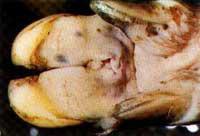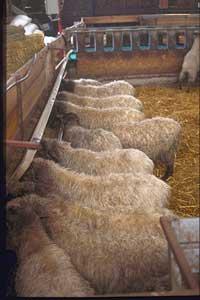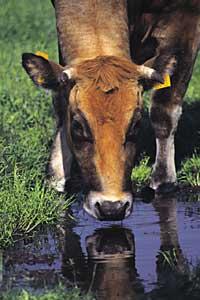Foot and mouth disease
2001/03/08 Galarraga Aiestaran, Ana - Elhuyar Zientzia
What appeared in February as a single case in a British hacienda is becoming an increasingly serious problem in this country. As a result, other countries have also had to take steps to prevent foot and mouth disease from becoming an epidemic across Europe.
What is foot and mouth disease?
FMD is caused by a virus of the genus Aphthovirus that affects animals that have the apatxa divided into two parts: cattle, sheep, goat, pig and wild ruminants.

The most significant symptoms of the disease are those called fever or increased body temperature and sores or vesicles. These vesicles appear in the oral and nasal mucous membranes, even between the hoofs. Therefore, in some places it is called duck, duck or hankamin, among other names. In other places it is also called navarrería and this is also called another human disease. Although both have similar symptoms, it is not the same disease. Names, both diseases are produced by different viruses and foot and mouth disease does not affect humans.
It is a serious disease in livestock. In adults the mortality rate is low (5%), but in young people it is higher than 50% and normally die from a heart attack. In addition, among survivors it also generates problems forever. For example, cattle production is reduced, weight is lost and abortions occur. Sheep and dairy goats stop giving milk.
Control measures
Because it is a disease that spreads very easily, drastic measures must be taken to stop the spread. In fact, the virus uses almost all transmission routes: direct or indirect contact, live vectors (animals or people who do not suffer the disease), inanimate vectors (vehicles) and air (without any other help, the air can extend to 60 km on land surface and travel 300 km on surface).
On the other hand, animals with viruses can also carry the disease, either because the virus is in an incubation period of 2-14 days, or because it has overcome the disease and the virus is inside the body.

In countries where FMD is endemic, a vaccine is used to eradicate the disease and, for example, vaccination campaigns are being carried out in many countries in South America in recent years. The vaccine was first developed in the 1960s with a virus killed by ultraviolet rays or chemicals.
However, incorporation is a problem. When the virus is in the vaccine, it "rises" and reappears. Therefore, it is not used in those countries where the disease is considered to have disappeared, as for example in Europe for more than ten years that no vaccination is performed. New vaccines with virus peptides are now being investigated, as effective as those with the whole virus, which would prevent its resurrection.
As for Europe, to prevent current cases from becoming pests, strict border disinfection measures have been adopted and animals are being slaughtered and buried in affected areas. In this epoch of globalization, despite the difficulty of putting limits on the virus of easy diffusion, throughout Europe the disease is being controlled.

Gai honi buruzko eduki gehiago
Elhuyarrek garatutako teknologia






